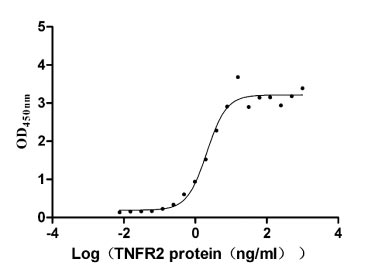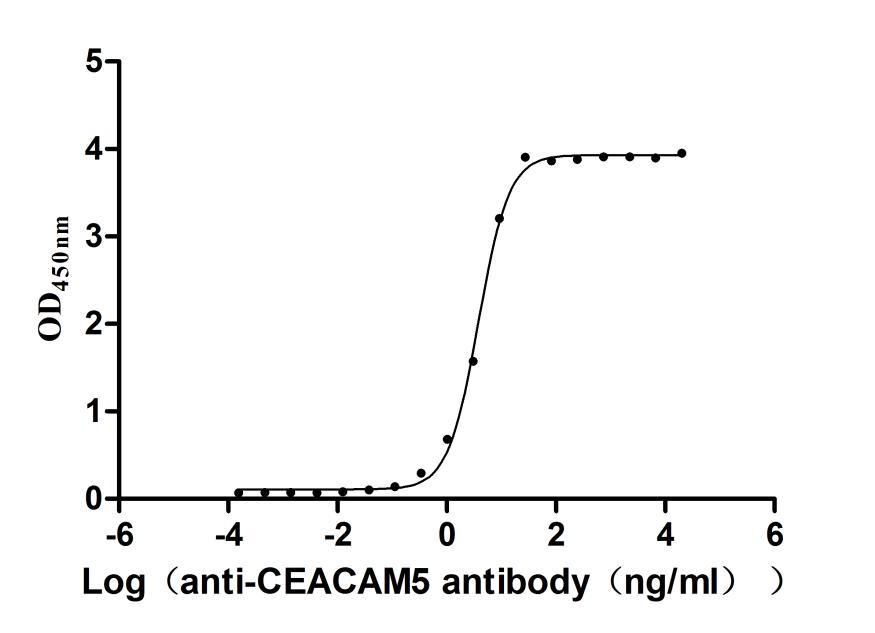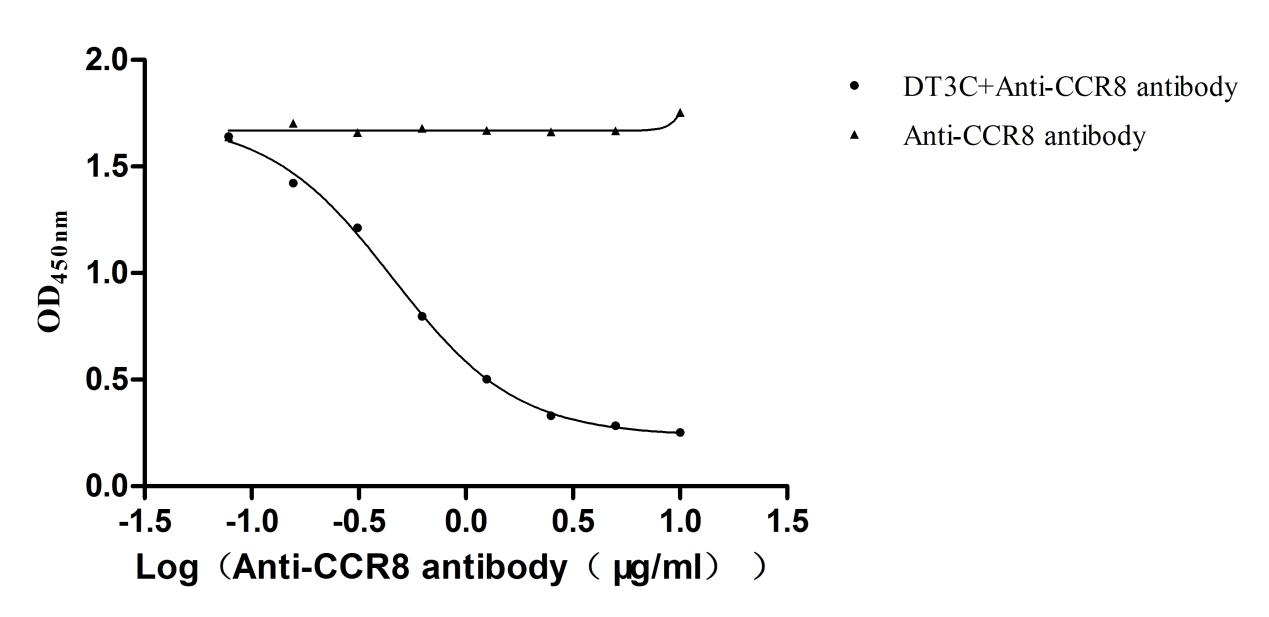Recombinant Human Prostacyclin receptor (PTGIR), partial
-
货号:CSB-YP018981HU1
-
规格:
-
来源:Yeast
-
其他:
-
货号:CSB-EP018981HU1
-
规格:
-
来源:E.coli
-
其他:
-
货号:CSB-EP018981HU1-B
-
规格:
-
来源:E.coli
-
共轭:Avi-tag Biotinylated
E. coli biotin ligase (BirA) is highly specific in covalently attaching biotin to the 15 amino acid AviTag peptide. This recombinant protein was biotinylated in vivo by AviTag-BirA technology, which method is BriA catalyzes amide linkage between the biotin and the specific lysine of the AviTag.
-
其他:
-
货号:CSB-BP018981HU1
-
规格:
-
来源:Baculovirus
-
其他:
-
货号:CSB-MP018981HU1
-
规格:
-
来源:Mammalian cell
-
其他:
产品详情
-
纯度:>85% (SDS-PAGE)
-
基因名:
-
Uniprot No.:
-
别名:PTGIR; PRIPR; Prostacyclin receptor; Prostaglandin I2 receptor; PGI receptor; PGI2 receptor; Prostanoid IP receptor
-
种属:Homo sapiens (Human)
-
蛋白长度:Partial
-
蛋白标签:Tag type will be determined during the manufacturing process.
The tag type will be determined during production process. If you have specified tag type, please tell us and we will develop the specified tag preferentially. -
产品提供形式:Lyophilized powder
Note: We will preferentially ship the format that we have in stock, however, if you have any special requirement for the format, please remark your requirement when placing the order, we will prepare according to your demand. -
复溶:We recommend that this vial be briefly centrifuged prior to opening to bring the contents to the bottom. Please reconstitute protein in deionized sterile water to a concentration of 0.1-1.0 mg/mL.We recommend to add 5-50% of glycerol (final concentration) and aliquot for long-term storage at -20℃/-80℃. Our default final concentration of glycerol is 50%. Customers could use it as reference.
-
储存条件:Store at -20°C/-80°C upon receipt, aliquoting is necessary for mutiple use. Avoid repeated freeze-thaw cycles.
-
保质期:The shelf life is related to many factors, storage state, buffer ingredients, storage temperature and the stability of the protein itself.
Generally, the shelf life of liquid form is 6 months at -20°C/-80°C. The shelf life of lyophilized form is 12 months at -20°C/-80°C. -
货期:Delivery time may differ from different purchasing way or location, please kindly consult your local distributors for specific delivery time.Note: All of our proteins are default shipped with normal blue ice packs, if you request to ship with dry ice, please communicate with us in advance and extra fees will be charged.
-
注意事项:Repeated freezing and thawing is not recommended. Store working aliquots at 4°C for up to one week.
-
Datasheet :Please contact us to get it.
相关产品
靶点详情
-
功能:Receptor for prostacyclin (prostaglandin I2 or PGI2). The activity of this receptor is mediated by G(s) proteins which activate adenylate cyclase.
-
基因功能参考文献:
- these studies are not only the first to identify alpha4 helix of Rab11a as a protein binding domain on the GTPase but also reveal novel mechanistic insights into the intracellular trafficking of the human prostacyclin receptor (hIP), and potentially of other members of the GPCR superfamily, involving Rab11-dependent mechanisms. PMID: 28739266
- role of IP-PPARdelta signal transduction pathway in the production of sAPPalpha in cerebral microvasculature. PMID: 26661245
- Data (including data from studies using transgenic mice, an murine experimental model of diabetes, and mouse/human cell lines) suggest prostaglandin I2 receptor (PTGIR) is involved in insulin secretion in pancreatic beta-cells and in permselectivity in glomerular podocytes; the mechanism appears to involve regulation of post-translational phosphorylation of nephrin. PMID: 26868296
- The human prostacyclin receptor gene is under the transcriptional regulation of dihydrotestosterone, where this regulation is further influenced by serum-cholesterol levels. PMID: 27365208
- cPGI2 generates via its cognate cell-surface receptor IP-R, converting white adipocytes to brite adipocytes. PMID: 26775637
- these findings suggest that reduced IPR expression in DM2 platelets may contribute to platelet hyperactivity in humans with type 2 diabetes. PMID: 25617843
- A total of 38 non-synonymous mutations were identified within the coding region of the hIP receptor, mapping to 36 distinct residues, including several mutations previously reported to affect the signaling of the hIP receptor. PMID: 24886841
- Prostaglandin I2- Prostaglandin I2 receptor signaling regulates human Th17 and Treg cell differentiation. PMID: 24035274
- The present report is the first to show an association between the A984C polymorphism of the IP gene and platelet activation in Japanese subjects. PMID: 23628440
- these data provide critical insights into the transcriptional regulation of the human prostacyclin receptor gene within the vasculature, including during megakaryocytic differentiation PMID: 22381139
- IP receptor heteridimerization with thromboxane receptor facilitates receptor trafficking to membrane lipid rafts. PMID: 23162015
- Prostacyclin receptor-dependent inhibition of human erythroleukemia cell differentiation is STAT3-dependent PMID: 22336225
- IKEPP was also found to be expressed in vascular endothelial cells where it co-localizes and complexes with the hIP PMID: 22884631
- the IP receptor was expressed in blood vessels of renal cell carcinoma specimens, but not in glomerular vessels of normal renal tissue; findings suggest the IP receptor might maintain an angiogenic switch in the "on" state in tumor endothelial cells (TEC); suggest that the IP receptor is a TEC-specific marker and might be a useful therapeutic target PMID: 22380928
- VDAC is the ATP conduit in the IP receptor-mediated signaling pathway in human erythrocytes. PMID: 22159995
- Human prostacyclin receptor interacts with the PDZ adapter protein PDZK1; this interaction plays important role in endothelial cell migration and angiogenesis. PMID: 21653824
- study identified a novel 8 residue ER export motif within the functionally important alpha-H8 of the hIP. PMID: 21223948
- decreased maternal plasma levels in severe preeclamptic pregnant women PMID: 20482519
- of 18 non-synonymous mutations, all with frequencies less than 2% in our study cohort, eight of the 18 had defects in binding, activation, and/or protein stability/folding PMID: 21189259
- IP(R212C) exerts a dominant action on the wild-type IP and thromboxane receptor through dimerization. This likely contributes to accelerated cardiovascular disease in individuals carrying 1 copy of the variant allele. PMID: 20522800
- The human IP gene is directly regulated by estrogen that largely occurs through an ERalpha-dependent transcriptional mechanism. PMID: 20070947
- Impaired receptor binding and activation associated with polymorphism PMID: 11854299
- role in protein isoprenylation PMID: 11895442
- Data show that prostacyclin receptor mediated increases in cAMP play a role in enhancing LPS/IFN-gamma-induced iNOS expression in human monocytes/macrophages and may contribute to the increased production of NO during peritonitis. PMID: 12119468
- identification of a unique ligand-binding pocket by site-directed mutagenesis and molecular modeling PMID: 12446735
- current state of knowledge of the prostacyclin receptor, its signaling and regulation, and its biological role in vivo [review] PMID: 12481546
- activation-dependent internalization of this receptor PMID: 12664600
- the presence of a free heavy chain IgG in the circulation from spinal cord-injured subjects blocked insulin receptor binding sites and also blocked the prostacyclin receptor interaction in platelets; insulin-induced NO synthesis was markedly impaired. PMID: 12850828
- Iloprost stimulation (1 microM, 2 h) of IP prostanoid receptor expressed in HEK293 cells resulted in specific decrease of endogenous G(s)alpha protein in detergent-insensitive, caveolin-enriched, membrane domains PMID: 15053924
- elucidated the molecular requirements for receptor activation within the region of the ligand-binding pocket, identifying transmembrane residues affecting potency PMID: 15248755
- The -CSLC motif of the IP is a direct target for inhibition by the FTI SCH66336, and in the presence of strong farnesyltransferase inhibition, the IP does not undergo compensatory geranylgeranylation. PMID: 15469414
- prostacyclin and thromboxane receptor dimerization facilitates thromboxane receptor-mediated cAMP generation PMID: 15471868
- results demonstrate for the first time that prostacyclin receptor activation by cicaprost can lead to STAT1 and STAT3 phosphorylations via signaling pathways involving pertussis toxin-insensitive G proteins, ERK and JNK PMID: 15979846
- The first intracellular loop of human prostacyclin receptor (IP) was proposed to be involved in signaling via its interaction with the Galphas protein. PMID: 16114876
- PGI-IP interaction within glandular epithelial cells can promote the expression of proangiogenic genes in human endometrium via cross talk with the EGFR. PMID: 16373414
- These data suggest that iloprost modulates VSMC phenotype via G(s) activation of the cAMP/PKA pathway. PMID: 16399867
- AC6 overexpression in endothelial cells may have use as a means to enhance prostacyclin function and reduce endothelial barrier permeability. PMID: 16885208
- results indicate that the three residues (E392-L394) of the Galphas protein predicted from NMR peptide studies, and the IP iLP1 and iLP3 play important roles in the Galphas-mediated IP receptor signaling in the cells. PMID: 16942748
- analysis of roles of cysteine residues in human prostacyclin receptor structure and function PMID: 17015447
- Three Arg-targeted changes at the same 212 position within the third cytoplasmic loop of the human prostacyclin (hIP) receptor were detected. PMID: 17481829
- The charged residues and the presence of naturally occurring mutations in prostacyclin receptor have important implications in the rational design of prostacyclin agonists for treating cardiovascular disease. PMID: 17704830
- Prostaglandin I(2) receptor (IP) was more specifically expressed in hair cuticle layer and outer root sheath (ORS) basal layer. PMID: 18005048
- A profile of the residues in the second extracellular loop that are critical for ligand recognition of human prostacyclin receptor PMID: 18042246
- IP-receptor agonists may limit the mitogenic actions of thrombin in human SMC by downregulating PAR-1 via modulation of cAMP-/PKA- and Rac1-dependent signaling pathways. PMID: 18162607
- diminished prostacyclin receptor signaling may contribute, in part, to the underlying adverse cardiovascular outcomes observed with cyclooxygenase-2 inhibition. PMID: 18323528
- A propensity of enhanced platelet activation in deep vein thrombosis patients with PTGIR polymorphisms V53V/S328S; A dysfunctional PTGIR polymorphism (R212C) associated with intimal hyperplasia. PMID: 18551041
- Co-stimulation of G(s) and G(q) can result in the fine-tuning of STAT3 activation status, and this may provide the basis for cell type-specific responses following activation of hIP. PMID: 18755267
- The prostacyclin receptor plays a central role in regulating its recycling following agonist activation by rab11 protein binding domain within its C-tail domain. PMID: 18832025
- These data provide critical insights into the transcriptional regulation of the IP gene in human megakaryocytic and endothelial cells, identifying Sp1, PU.1 and Oct-1 as the critical factors involved in its basal regulation in humans. PMID: 19118563
显示更多
收起更多
-
亚细胞定位:Cell membrane; Multi-pass membrane protein.
-
蛋白家族:G-protein coupled receptor 1 family
-
数据库链接:
HGNC: 9602
OMIM: 600022
KEGG: hsa:5739
STRING: 9606.ENSP00000291294
UniGene: Hs.458324
Most popular with customers
-
Recombinant Human B- and T-lymphocyte attenuator (BTLA), partial (Active)
Express system: Mammalian cell
Species: Homo sapiens (Human)
-
Recombinant Human Lymphotoxin-alpha (LTA) (Active)
Express system: Mammalian cell
Species: Homo sapiens (Human)
-
Recombinant Human Tumor necrosis factor ligand superfamily member 8 (TNFSF8), partial (Active)
Express system: Mammalian cell
Species: Homo sapiens (Human)
-
Recombinant Human C5a anaphylatoxin chemotactic receptor 1 (C5AR1)-VLPs (Active)
Express system: Mammalian cell
Species: Homo sapiens (Human)
-
Recombinant Human Serine/threonine-protein kinase receptor R3 (ACVRL1), partial (Active)
Express system: Baculovirus
Species: Homo sapiens (Human)
-
Recombinant Human Myosin regulatory light chain 12B(MYL12B) (Active)
Express system: E.coli
Species: Homo sapiens (Human)
-
Express system: Mammalian cell
Species: Macaca mulatta (Rhesus macaque)
-
Recombinant DT3C (Diphtheria toxin & spg 3C domain) for Antibody Internalization Assay (Active)
Express system: E.coli
Species: N/A




















